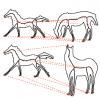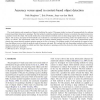88 search results - page 10 / 18 » Learning the Compositional Nature of Visual Objects |
ICCV
2009
IEEE
15 years 18 days ago
2009
IEEE
We present a shape-based algorithm for detecting and
recognizing non-rigid objects from natural images. The existing
literature in this domain often cannot model the objects
ver...
PRL
2007
13 years 7 months ago
2007
The visual detection and recognition of objects is facilitated by context. This paper studies two types of learning methods for realizing context-based object detection in paintin...
CVPR
2009
IEEE
15 years 2 months ago
2009
IEEE
The visual world demonstrates organized spatial patterns,
among objects or regions in a scene, object-parts
in an object, and low-level features in object-parts. These
classes o...
AAAI
2008
13 years 10 months ago
2008
To truly understand language, an intelligent system must be able to connect words, phrases, and sentences to its perception of objects and events in the world. Current natural lan...
HRI
2006
ACM
14 years 1 months ago
2006
ACM
The essence of the signal-to-symbol problem consists of associating a symbolic description of an object (e.g., a chair) to a signal (e.g., an image) that captures the real object....



